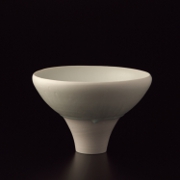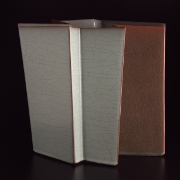| Imada Yoko Imada Yoko is an up-and-coming young artist who lives and works near Nagoya, Japan. Her works
embody vessel forms, but they are not merely functional. Rather, they borrow the vessel form to expound the artist's inner conception
of beauty, which is something that is classical and does not simply change with passing trends or fads. Instead, the vessel form is a
style that does not grow old, and this sheds light upon its primal allure.
Porcelain is her muse, and she throws her works upon
a potter's wheel. However, Imai only creates basic forms upon the wheel. The great proportion of her sleek silhouettes are borne from
carving and shaving off excess clay from the clay body once a work is thrown and dried. After this, she pours various white and bluish
glazes over her works, and fires them in her gas kiln at 1260 degrees Celsius. She also wields stunning action-painting-like displays
of "gosu" cobalt overglaze in her works, giving her white, minimal bodies a splash of color and grace.
Atsushi Takagaki Originally conceived by imperial craftsmen for the delectation of kings and emperors, celadon is a legendary
and historic form of glazed stoneware widely considered by critics and connoisseurs to be one of the great treasures of Chinese civilization.
The artistry behind the notoriously difficult celadon glazing remains with us today in the likes of skilled contemporary artists such as
Atsushi Takagaki (1946- ). Yet unlike the masters of old, Takagaki has rejuvenated the style with his many experiments into unlocking the
mysteries of celadon glazing, allowing the artist to create sparkling yet subtle scarlet hues buried within serene seas of celadon green.
Wielding original, asymmetrical forms that directly confront the almost mechanical execution of medieval celadon, the stature of Takagaki
as a celadon artist has grown exponentially in the past several years, in part due to his receiving the Award of Excellence at the Asahi
Ceramics Exhibition in 2005 and at the 2nd Kikuchi Biennale in 2007.
Takuo Nakamura Affectionately called "Little Kyoto" by the Japanese, the city of Kanazawa experienced great prosperity during
the Edo Period and flourished as one of the most culturally affluent domains in all of Japan. Nakamura (1945- ) is a ceramic artist whose
family is deeply rooted in the ceramic traditions of the region. Yet rather than dwelling on the utilitarian forms of the past, Nakamura
has developed new and abstract silhouettes that have broken free from the constrictions imposed by the vessel format, while at the same
time, has incorporated elegantly vivid enamel designs that call to mind the Momoyama-period grandeur exhibited by the legendary Rimpa school
of Japanese painting. Nakamura's wildly original works, in both abstract and functional formats, have been collected widely by museums the
world over, namely the Metropolitan Museum in New York and the Art Institute of Chicago, among many others, and the artist is considered to
be one of the premier ceramic artists working in Kanazawa today. Nakamura's works are odes to the beauty of Momoyama grandeur. Yet at the
same time, they are dashing representations of Nakamura's deft technique with his brush. His stoneware objects are like canvasses to a painting,
and help capture the artist's unique ability to control both space and time through the utmost in ceramic lyricism. |

















